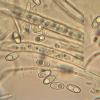
29-10-2013 00:21
 Rubén Martínez-Gil
Rubén Martínez-Gil
Hola a todos.Esta es la 3ª vez que encontramos en

27-10-2013 21:12
Marcus YeoI recently found this Rutstroemia growing on dead

27-10-2013 09:35
René DougoudBonjour cers Tous,Je recherche cette publication,

27-10-2013 09:34
Peter ThompsonHello Everyone,I recently found a Coprotus species

22-10-2013 21:51
Jean-Luc RangerBonjour à tous, Voici une Otidea qui semble corre
Otidea onotica
Luis Ballester,
29-10-2013 16:49
 Hola a todos.
Hola a todos.Nous trouvons cette Otidea le samedi 26/10/13 en La Rioja dans un habitat très rare par-ci, sous Picea abies.
Après le transport, les exemplaires se sont remplis des taches abondantes rouges très évidentes.
Taille des spores: 13-14 x 6,5-7,5 µm. Moyenne 13,4 x 6,8 µm.
Je pense qu'il s'agit d'Otidea onotica.
Luis
Hola a todos.
Encontramos esta Otidea el sábado 26/10/13 en la Rioja en un hábitat muy infrecuente por aquí, bajo Picea abies.
Tras el transporte, los ejemplares se llenaron de abundantes manchas rojas muy evidentes.
Tamaño de las esporas: 13-14 x 6,5-7,5 µm. Promedio 13,4 x 6,8 µm.
Pienso que se trata de Otidea onotica.
Luis


